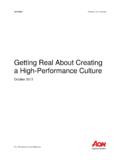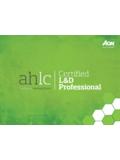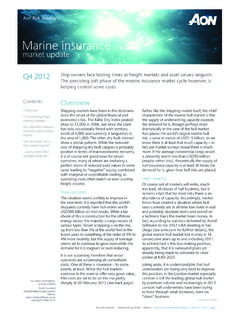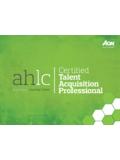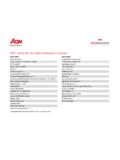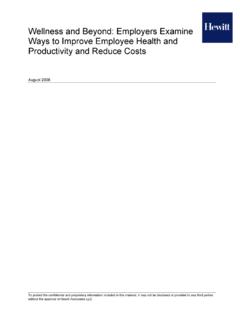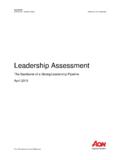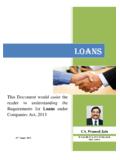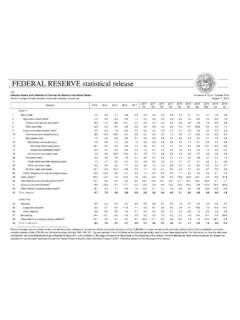Transcription of Leakage of Participants’ DC Assets: How Loans, Withdrawals ...
1 Consulting Outsourcing Retirement Leakage of Participants' DC Assets: How Loans, Withdrawals , and Cashouts Are Eroding Retirement Income 2011. Leakage of Participants' DC Assets: How Loans, Withdrawals , and Cashouts Are Eroding Retirement Income Contents 3 Background 4 Loans 7 Withdrawals 10 Cashouts 13 Perspectives and Recommendations on Leakage 17 Conclusions 18 References 18 Contact Information Background As many studies have shown, there's a growing gap between retirement needs and resources. According to a recent Aon Hewitt report, Retirement Income Adequacy at Large Companies: The Real Deal 2010, only one in five full-career contributors in large 401(k) plans is projected to be able to meet their needs in retirement.
2 On average, these savers are expected to have a shortfall of times their final pay upon retirement. Many factors contribute to the savings shortfall, including volatile investment markets, rapidly increasing health care costs and reduced pensions from defined benefit plans. In addition, the real deal study makes one major assumption . that participants do not take any funds out of retirement savings prematurely. In reality, savings leak out of the system before participants retire, further eroding retirement readiness. This study examines the three main sources of Leakage : n Loans taken out and sometimes not repaid in full n Withdrawals taken during active employment n Cashing out retirement savings upon a job termination This report explores the magnitude of the problems, their impact to participant savings and ideas to curb these behaviors.
3 More than million employees were examined across over 110 large defined contribution plans. participant data was analyzed through year-end 2010. Additionally, the Aon Hewitt 2010 Employer Perspectives on Defined Contribution Plan Leakage Survey was deployed in October 2010 to gauge employer sentiment and plans related to Leakage issues (in total, 200 plan sponsors responded). Finally, Employee Benefit Research Institute (EBRI) provided modeling as to the impact of employee actions through its EBRI Retirement Security Projection Model . Loans Withdrawals Cashouts Leakage of Participants' DC Assets: How Loans, Withdrawals , and Cashouts Are Eroding Retirement Income 3. Loans Loans are generally considered an attractive feature in a defined contribution (DC) plan.
4 The knowledge that money is accessible may encourage some employees to save in a plan. Taking a loan from a DC plan may be preferred over other alternatives like high-interest rate credit card loans. If participants continue contributing to the plan while paying off their loans and (eventually) pay off the loan in full, their retirement savings are generally preserved. However, when participants take excessive loans or default on outstanding loans, it can undermine the purpose of the plan and can put participants' retirement income adequacy at risk. A loan feature is available in nearly all defined contribution plans. According the Aon Hewitt 2010 Employer Perspectives on Defined Contribution Plan Leakage Survey, 95% of plans have a loan provision.
5 Virtually all these plans offer general- purpose loans, meaning loans can be for any purpose and have a repayment period of up to five years. Additionally, over three quarters also allow participants to take loans for the purchase of a home with an extended repayment period of up to 10 to 30 years. The majority of plans (58%) permit participants to have two or more loans outstanding at any given time. The loan feature is highly utilized by participants in DC plans. Through the mid-2000s, loan usage was fairly steady. However, in the years following the 2008 financial crisis, loan usage has steadily climbed. As of year-end 2010, nearly 28% of active participants had a loan outstanding, which is a record high.
6 Nearly 14% of participants initiated new loans during 2010, slightly higher than previous years. The average balance of the outstanding amount was $7,860, which represented 21% of these participants' total plan assets. Although the majority of the participants ( ) had only one loan outstanding, had two loans outstanding simultaneously and had more than two loans. Percentage of Participants With Loans Over Time Percentage of Participants With Loans By Age 4 Aon Hewitt loan usage varies significantly based on the participant 's situation: n Middle-aged and middle-income participants are most likely to have outstanding loans participants in their 40s, and those earning between $40,000 and $60,000 had significantly higher loan prevalence.
7 N Women with lower salaries are more apt to take loans than their similarly paid male counterparts. In fact, among those earning between $20,000 and $40,000, of women had a loan outstanding versus of men. n Women are also more likely to take more than one loan at a given time as compared to men. A majority of the participants with a loan continued to contribute in their DC plan. Overall, of participants with outstanding loans continued to defer contributions to the DC plan. However, the average savings rate of those with loans was slightly lower ( of pay) than those who did not have loans outstanding ( of pay). Generally speaking, the employees who stopped deferring to the plan while repaying their loans are lower-earning individuals in their 30s or 40s.
8 Defaulting on a loan makes the Leakage permanent, which significantly impairs retirement saving. The most likely point of default occurs when a participant has a loan outstanding at employment termination. Presently, the vast majority of plans require employees to repay loans in full upon termination of employment (usually within 60 days). This can be challenging for employees, and many subsequently default on the loan causing the money to be treated as a taxable distribution and subject to penalties for those under age 59 . When employees with loans terminate employment, nearly 70% subsequently default on the repayment. Among participants in their 20s, the default percentage jumps to nearly 80%.
9 In contrast, on average, active employees default on their loans less than 3% of the time. loan Defaults Among Terminated Employeess By Age Leakage of Participants' DC Assets: How Loans, Withdrawals , and Cashouts Are Eroding Retirement Income 5. Impact of loans on participant retirement security EBRI's Retirement Security Projection Model simulated the impact of loans on DC participant retirement savings. The projection simulates a full-career employee who takes a loan and then stops saving for the duration of the loan repayment period (five years). The projections assume the individuals are in the middle to early part of their careers. Ceasing deferrals during the loan repayment period is expected to erode future retirement income by 10% to 13%, depending on the type of enrollment (automatic or voluntary) and the participant 's income level.
10 If two loans are taken, this reduction nearly doubles. On the other hand, if the participant continues to save during the repayment period, the loan causes little changes to expected retirement income. Defaulting on the loan by terminated employees paints a more ominous picture as the default permanently removes monies from the retirement system. Median Balance Reduction as Result of One loan ( loan is Repaid). 6 Aon Hewitt Withdrawals As tax-qualified plans, DC plans must limit participants' ability to withdraw their savings before they terminate employment. These Withdrawals are permanent and cannot be redeposited in the future, yet many organizations make these options available. n In general, plans cannot allow Withdrawals of before-tax savings in a DC plan except as a last resort when financial crisis occurs (a hardship withdrawal ).


